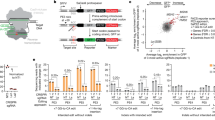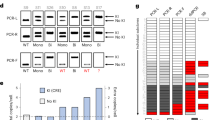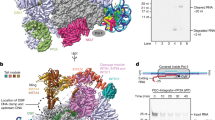Abstract
The DNA polymerase V (pol V) and RecA proteins are essential components of a mutagenic translesion synthesis pathway in Escherichia coli designed to cope with DNA damage. Previously, it has been assumed that RecA binds to the DNA template strand being copied. Here we show, however, that pol-V-catalysed translesion synthesis, in the presence or absence of the β-processivity-clamp, occurs only when RecA nucleoprotein filaments assemble or RecA protomers bind on separate single-stranded (ss)DNA molecules in trans. A 3′-proximal RecA filament end on trans DNA is essential for stimulation; however, synthesis is strengthened by further pol V–RecA interactions occurring elsewhere along a trans nucleoprotein filament. We suggest that trans-stimulation of pol V by RecA bound to ssDNA reflects a distinctive regulatory mechanism of mutation that resolves the paradox of RecA filaments assembled in cis on a damaged template strand obstructing translesion DNA synthesis despite the absolute requirement of RecA for SOS mutagenesis.
This is a preview of subscription content, access via your institution
Access options
Subscribe to this journal
Receive 51 print issues and online access
$199.00 per year
only $3.90 per issue
Buy this article
- Purchase on Springer Link
- Instant access to full article PDF
Prices may be subject to local taxes which are calculated during checkout




Similar content being viewed by others
References
Radman, M. in Molecular and Environmental Aspects of Mutagenesis (eds Prakash, L., Sherman, F., Miller, M. W., Lawrence, C. W. & Tabor, H. W.) 128–142 (Charles C. Thomas, Springfield, Illinois, 1974)
Witkin, E. M. Ultraviolet mutagenesis and inducible DNA repair in Escherichia coli. Bacteriol. Rev. 40, 869–907 (1976)
Friedberg, E. C. et al. DNA Repair and Mutagenesis 2nd edn, 461–555 (ASM Press, Washington DC, 2006)
Goodman, M. F. Error-prone repair DNA polymerases in prokaryotes and eukaryotes. Annu. Rev. Biochem. 71, 17–50 (2002)
Tang, M. et al. Biochemical basis of SOS-induced mutagenesis in Escherichia coli: reconstitution of in vitro lesion bypass dependent on the UmuD′2C mutagenic complex and RecA protein. Proc. Natl Acad. Sci. USA 95, 9755–9760 (1998)
Tang, M. J. et al. UmuD′2C is an error-prone DNA polymerase, Escherichia coli pol V. Proc. Natl Acad. Sci. USA 96, 8919–8924 (1999)
Reuven, N. B., Arad, G., Maor-Shoshani, A. & Livneh, Z. The mutagenesis protein UmuC is a DNA polymerase activated by UmuD', RecA and SSB, and is specialized for translesion replication. J. Biol. Chem. 274, 31763–31766 (1999)
Fujii, S., Gasser, V. & Fuchs, R. P. The biochemical requirements of DNA polymerase V-mediated translesion synthesis revisited. J. Mol. Biol. 341, 405–417 (2004)
Nohmi, T., Battista, J. R., Dodson, L. A. & Walker, G. C. RecA-mediated cleavage activates UmuD for mutagenesis: mechanistic relationship between transcriptional derepression and posttranslational activation. Proc. Natl Acad. Sci. USA 85, 1816–1820 (1988)
Dutreix, M. et al. New recA mutations that dissociate the various RecA protein activities in Escherichia coli provide evidence for an additional role for RecA protein in UV mutagenesis. J. Bacteriol. 171, 2415–2423 (1989)
Sweasy, J. B., Witkin, E. M., Sinha, N. & Roegner-Maniscalco, V. RecA protein of Escherichia coli has a third essential role in SOS mutator activity. J. Bacteriol. 172, 3030–3036 (1990)
Pham, P. et al. A model for SOS-lesion targeted mutations in E. coli involving pol V, RecA, SSB and β sliding clamp. Nature 409, 366–370 (2001)
Reuven, N. B. et al. Lesion bypass by the Escherichia coli DNA polymerase V requires assembly of a RecA nucleoprotein filament. J. Biol. Chem. 276, 5511–5517 (2001)
Bridges, B. A. & Woodgate, R. Mutagenic repair in Escherichia coli. X. The umuC gene product may be required for replication past pyrimidine dimers but not for the coding error in UV-mutagenesis. Mol. Gen. Genet. 196, 364–366 (1984)
Sommer, S., Boudsocq, F., Devoret, R. & Bailone, A. Specific RecA amino acid changes affect RecA–UmuD' C interaction. Mol. Microbiol. 28, 281–291 (1998)
Schlacher, K. et al. DNA polymerase V and RecA protein, a minimal mutasome. Mol. Cell 17, 561–572 (2005)
Pham, P. et al. Two distinct modes of RecA action are required for DNA polymerase V-catalyzed translesion synthesis. Proc. Natl Acad. Sci. USA 99, 11061–11066 (2002)
Maor-Shoshani, A., Reuven, N. B., Tomer, G. & Livneh, Z. Highly mutagenic replication by DNA polymerase V (UmuC) provides a mechanistic basis for SOS untargeted mutagenesis. Proc. Natl Acad. Sci. USA 97, 565–570 (2000)
Fujii, S. & Fuchs, R. P. Defining the position of the switches between replicative and bypass DNA polymerases. EMBO J. 23, 4342–4352 (2004)
Rupp, W. D. & Howard-Flanders, P. Discontinuities in the DNA synthesized in an excision-defective strain of Escherichia coli following ultraviolet irradiation. J. Mol. Biol. 31, 291–304 (1968)
Stohl, E. A. et al. Escherichia coli RecX inhibits RecA recombinase and coprotease activities in vitro and in vivo. J. Biol. Chem. 278, 2278–2285 (2003)
Drees, J. C. et al. A RecA filament capping mechanism for RecX protein. Mol. Cell 15, 789–798 (2004)
Bailone, A. et al. A RecA protein mutant deficient in its interaction with the UmuD' C complex. Biochemie 73, 479–484 (1991)
Eggler, A. L., Lusetti, S. L. & Cox, M. M. The C terminus of the Escherichia coli RecA protein modulates the DNA binding competition with single-stranded DNA-binding protein. J. Biol. Chem. 278, 16389–16396 (2003)
Lavery, P. E. & Kowalczykowski, S. C. Biochemical basis of the constitutive repressor cleavage activity of recA730 protein. A comparison to recA441 and recA803 proteins. J. Biol. Chem. 267, 20648–20658 (1992)
VanLoock, M. S. et al. ATP-mediated conformational changes in the RecA filament. Structure 11, 187–196 (2003)
Frank, E. G. et al. Visualization of two binding sites for the Escherichia coli UmuD′2C complex (DNA pol V) on RecA–ssDNA filaments. J. Mol. Biol. 297, 585–597 (2000)
Boudsocq, F., Campbell, M., Devoret, R. & Bailone, A. Quantitation of the inhibition of Hfr × F- recombination by the mutagenesis complex UmuD' C. J. Mol. Biol. 270, 201–211 (1997)
Sommer, S., Bailone, A. & Devoret, R. The appearance of the UmuD' C protein complex in Escherichia coli switches repair from homologous recombination to SOS mutagenesis. Mol. Microbiol. 10, 963–971 (1993)
Maor-Shoshani, A. M. & Livneh, Z. Analysis of the stimulation of DNA polymerase V of Escherichia coli by processivity proteins. Biochemistry 41, 14438–14446 (2002)
Kuzminov, A. Recombinational repair of DNA damage in Escherichia coli and bacteriophage lambda. Microbiol. Mol. Biol. Rev. 63, 751–813 (1999)
Acknowledgements
This work was supported by National Institutes of Health grants to M.F.G. and M.M.C., and funds from the NICHD/NIH Intramural Research Program to R.W.
Author information
Authors and Affiliations
Corresponding author
Ethics declarations
Competing interests
Reprints and permissions information is available at www.nature.com/reprints. The authors declare no competing financial interests.
Supplementary information
Supplementary Figures
This file contains a background figure (Supplementary Figure 1), supportive data (Supplementary Figures 2–12) and DNA sequences (Figure 13). (PDF 1094 kb)
Supplementary Methods
This file contains additional details of the Methods used in this study. (PDF 56 kb)
Rights and permissions
About this article
Cite this article
Schlacher, K., Cox, M., Woodgate, R. et al. RecA acts in trans to allow replication of damaged DNA by DNA polymerase V. Nature 442, 883–887 (2006). https://doi.org/10.1038/nature05042
Received:
Accepted:
Issue Date:
DOI: https://doi.org/10.1038/nature05042
This article is cited by
-
Preferential D-loop extension by a translesion DNA polymerase underlies error-prone recombination
Nature Structural & Molecular Biology (2013)
-
Monitoring of biofilm production by Pseudomonas aeruginosa strains under different conditions of UVC irradiation and phage infection
Annals of Microbiology (2013)
-
Rad51 protects nascent DNA from Mre11-dependent degradation and promotes continuous DNA synthesis
Nature Structural & Molecular Biology (2010)
-
The active form of DNA polymerase V is UmuD′2C–RecA–ATP
Nature (2009)
-
Mechanisms of Dealing with DNA Damage-Induced Replication Problems
Cell Biochemistry and Biophysics (2009)
Comments
By submitting a comment you agree to abide by our Terms and Community Guidelines. If you find something abusive or that does not comply with our terms or guidelines please flag it as inappropriate.



